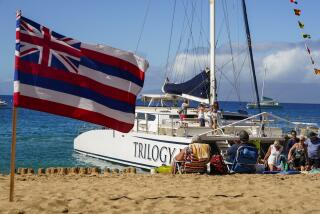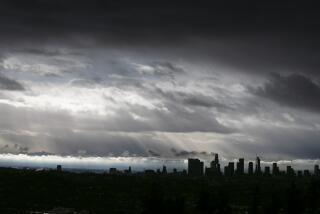Key West Tries to Get the Party Restarted
- Share via
KEY WEST, Fla. — The weekend after Hurricane Wilma swamped most of this tropical island city with an average of 4 feet of seawater, the party was on again for tourists in downtown Key West.
Sloppy Joe’s bar was packed by Saturday night, dancers at Victoria’s, a disco, had difficulty maneuvering on the jammed floor, and some enterprising shops had already begun selling “I Survived Wilma” T-shirts.
Beyond the main tourist boulevards, however, the scene was different. Along Flagler Avenue and other residential streets outside Old Town, curbs were piled with the sodden, damaged contents of inundated homes.
At Chicken Moyer’s home, friends came by to help the 55-year-old bartender get her Jeep Wrangler running. Wilma’s waters had been waist-high on the street where Moyer lives, ruining her stove and refrigerator and immersing two mopeds.
“A mechanic told us to hose off the underneath, change out the fluids and the filters, and give it a try,” said Vicky Gill, 51, a friend of Moyer’s who is also a bartender. The chums were still at work on the Jeep when a visitor left.
Wilma was not the Big One, the catastrophic major hurricane that residents throughout the Florida Keys dread, but it was the most damaging storm to hit this island since 1919, local authorities said.
Three times this year, and three times in the 2004 hurricane season, tourists -- Key West’s No. 1 source of revenue -- have been ordered to evacuate, said Michael Haskins, a public information officer for the city.
This year alone, hurricane scares wiped out the most lucrative events on the tourism calendar, the Caribbean-themed Goombay! Festival and Fantasy Fest, a sort of extended Halloween party for adults.
As visitors fled or canceled bookings by the thousands, estimated losses reached $133 million.
“Economically, what we lost is devastating and can’t be recouped,” said Julie Fondriest, owner of the Lighthouse Court, a 40-room guesthouse in Key West’s Old Town. “We’ve got an empty hotel, and we’re trying to get back into the swing of things. There are huge bills to pay, and our employees want to get paid.”
So much storm surge sloshed into the southernmost municipality in the continental United States from Hurricane Wilma, which hit Oct. 24, that 70% of the homes in Key West might need new drywall, Mayor Morgan McPherson said, citing a preliminary survey of storm damage. Carpeting, beds, furniture and thousands of automobiles, refrigerators and other appliances were soaked in saltwater and might have been ruined.
One of the most significant losses may have been the ability of many who ply their trades in Key West’s tourism sector, such as Moyer, to get to work.
Hundreds, perhaps thousands, of automobiles were swamped in Wilma’s surge, from rental cars in lots at Key West International Airport to Monroe County Sheriff’s Department patrol cruisers.
The consequences of such property damage could be far-reaching for the tourism industry. Already the cost of living in Key West, where the average house costs $800,000, was high for waiters, cooks, salespeople and others.
The mayor is worried that some of those service workers will leave. Affordable rental properties, already hard to come by, may become even more scarce as their owners use insurance payments to upgrade, he said.
“I’ve seen this walking door to door -- people saying, ‘I’m out of here,’ ” McPherson said. As soon as the island’s rental car agencies replace seawater-damaged cars with new ones, the mayor said, “I think you’ll see a mass exodus.”
On the other side of Whitehead Street from the Lighthouse Court, workers pressure-cleaned the facade of the two-story Spanish colonial residence where Ernest Hemingway lived while he wrote his novel “For Whom the Bell Tolls” and other works.
The home, which appeared to have evaded flood damage, is the most popular tourist attraction on the island. Ordinarily open 365 days a year, it was forced to close for a post-Wilma cleanup.
Officially, Key West and the rest of the Lower Keys will reopen to visitors today.
The first cruise ship to dock here since Wilma is due Tuesday, and on Wednesday, Duval Street, the main tourist strip, will be blocked off as thousands of Parrotheads -- as the fans of singer-songwriter Jimmy Buffett are known -- are expected to arrive for their annual conclave.
Several guesthouses said bookings were strong because of the event.
But some, such as the Lighthouse Court, said they did not expect to attract the usual large crowds for the rescheduled Fantasy Fest. The event, which customarily doubles the island’s population, will be held Dec. 7 through 10, and the theme has been updated to Wilma’s Freaks, Geeks and Goddesses.
Within four days of the encounter with Hurricane Wilma, 80% of local hotels were back in business, McPherson said.
“Tourism here is definitely sustainable,” said the mayor, a 36-year-old real estate agent who had been in office 17 days when Wilma hit.
In fact, McPherson said, the hurricane may have opened a new tourism market for Key West: people living in other areas of South Florida also affected by Wilma who may be yearning for a break from long gas lines, local boil-water orders or other privations.
“I’d put money on people from Fort Lauderdale, Miami, West Palm Beach coming to vacation here,” McPherson said. “We have electricity, and they don’t.”
As of Sunday, about 1 million customers of Florida Power & Light were reported to still lack power.
To help people get around, Key West began running a free neighborhood shuttle service this weekend to take residents to the grocery store and help them do other errands, said Haskins, the city spokesman.
Saturday evening, hundreds of Key Westers and out-of-towners who came despite the postponement of Fantasy Fest joined in an impromptu costume parade to some of downtown’s most popular bars, starting at the Hog’s Breath Saloon.
David Brakebill, 47, who moved from San Francisco to Key West four years ago, said he was taking the six hurricane warnings since the summer of 2004 in stride.
“Everywhere you live, it’s something,” Brakebill said. “Live in California, it’s fires, mudslides, earthquakes. In the Midwest, it’s tornadoes. People here are resilient. We’ll get over it.”
More to Read
Sign up for The Wild
We’ll help you find the best places to hike, bike and run, as well as the perfect silent spots for meditation and yoga.
You may occasionally receive promotional content from the Los Angeles Times.






